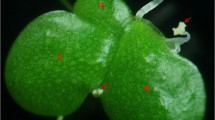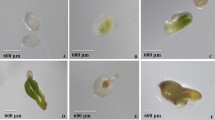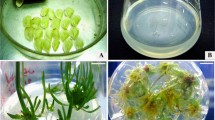Abstract
Interspecific hybridization was carried out between Lilium longiflorum and L. lophophorum var. linearifolium by using the cut style method of pollination, as a contrast, intraspecific hybridization between L. longiflorum ‘Gelria’ and L. longiflorum was also made, but no mature seeds and offspring were obtained from the two combinations under in vivo condition. Ovules excised from each carpel 5–35 days after pollination (DAP) were cultured on B5 or half-strength B5 medium containing sucrose at different concentrations in vitro. In L. longiflorum × L. lophophorum var. linearifolium, only 1.17% of ovules excised at 10 DAP developed into seedlings, and in L. longiflorum ‘Gelria’ × L. longiflorum, only 0.99% of ovules excised at 25 DAP developed into seedlings; none of the ovules excised at other different DAP in the two cross combinations produced any seedlings. The results showed that interspecific hybridization had a more serious post-fertilization barrier than the intraspecific hybridization, and that a lower concentration (3%) of sucrose led to better embryo development and higher percentage of seedlings in ovule cultures. All hybrid seedlings obtained were successfully transplanted to soil and grew normally. The progenies investigated were identified as true hybrids based on inter-simple sequence repeat (ISSR) analysis.






Similar content being viewed by others
Abbreviations
- BA:
-
6-Benzylaminopurine
- CSM:
-
Cut style method
- DAP:
-
Days after pollination
- ISSR:
-
Inter-simple sequence repeat
- NAA:
-
1-Naphthaleneacetic acid
References
Arzate-Fernández AM, Tanisaka T, Nakazaki T, Ikehashi H (1998) Efficient hybridization between Lilium × elegance and L. longiflorum through in vitro ovary slice culture. Breed Sci 48:71–75
Barba-Gonzalez R, Lokker AC, Lim K-B, Ramanna MS, Van Tuyl JM (2004) Use of 2n gametes for the production of sexual polyploids from sterile Oriental × Asiatic hybrids of lilies (Lilium). Theor Appl Genet 109:1125–1132. doi:10.1007/s00122-004-1739-0
Chi H-S (2002) Various embryo rescue methods in interspecific crosses of lily. Bot Bull Acad Sin 43:139–146
Comber HF (1949) A new classification of the genus Lilium. Lily Year Book RHS 13:86–105
Dowrick GJ, Brandam SN (1970) Abnormalities of endosperm development in Lilium hybrids. Euphytica 19:433–442. doi:10.1007/BF01902917
Doyle JJ, Doyle JL (1990) Isolation of plant DNA from fresh tissue. Focus 12:13–15
Fernández AM, Nakazaki T, Tanisaka T (1996) Development of diploid and triploid interspecific hybrids between Lilium longiflorum and L concolor by ovary slice culture. Plant Breed 115:167–171. doi:10.1111/j.1439-0523.1996.tb00895.x
Gamborg OL, Miller RA, Ojima K (1968) Nutrient requirements of suspension culture of soybean root cells. Exp Cell Res 50:151–158. doi:10.1016/0014-4827(68)90403-5
Hayashi M, Kanoh K, Serizawa Y, Yoon E (1986) Ovary slice culture of Lilium formosanum Wallace. Jpn J Breed 36:304–308
Ikeda N, Niimi Y, Han D-S (2003) Production of seedlings from ovules excised at the zygote stage in Lilium spp. Plant Cell Tissue Organ Cult 73:159–166. doi:10.1023/A:1022818413617
Kanoh K, Hayashi M, Serizawa Y, Konishi T (1988) Production of interspecific hybrids between Lilium longiflorum and Lilium × elegance by ovary slice culture. Jpn J Breed 38:278–282
Karlov GI, Khrustaleva LI, Lim KB, Van Tuyl JM (1999) Homoeologous recombination in 2n-gametes producing interspecific hybrids of Lilium (Liliaceae) studied by genomic in situ hybridization (GISH). Genome 42:681–686. doi:10.1139/gen-42-4-681
Li T-H, Niimi Y (1995) A comparison of seed sets in self-, intraspecific and interspecific pollination of Lilium species by stigmatic and cut-style pollination methods. J Jpn Soc Hortic Sci 64:149–159 (in Japanese)
Lim K-B, Van Tuyl JM (2007) Lily. In: Anderson NO (ed) Flower breeding and genetics. Springer, New Yok, pp 517–537
Lim K-B, Chung J-D, Van Kronenburg BCE, Ramanna, De Jong JH, Van Tuyl JM (2000) Introgression of Lilium rubellum Baker chromosomes into L. longiflorum Thunb.: a genome painting study of the F1 hybrid, BC1 and BC2 progenies. Chromosome Res 8:119–125. doi:10.1023/A:1009290418889
Matthews V (2007) Lily register and checklist 2007, the international 4th edn. The Royal Horticultural Society, London
Matthews D, McNicoll J, Harding K, Millam S (1999) 5’-Anchored simple-sequence repeats primers are useful for analysing potato somatic hybrids. Plant Cell Rep 19:210–212. doi:10.1007/s002990050735
McRae EA (ed) (1998) Lily species. In: Lilies: a guide for growers and collectors. Timber Press, Portland, Oregon, pp 105–204
Morgan ER, Burge GK, Seelye JF, Grant JE, Hopping ME (1995) Interspecific hybridisation between Limonium perigrinum and Limonium purpuratum. Euphytica 83:215–224. doi:10.1007/BF01678133
Murashige T, Skoog F (1962) A revised medium for rapid growth and bioassays with tobacco tissue cultures. Physiol Plant 15:473–497. doi:10.1111/j.1399-3054.1962.tb08052.x
Niimi Y, Nakano M, Goto M (1995) Comparison of seedling production among several embryo-rescue techniques in Lilium formosanum Wallace. Plant Tissue Cult Lett 12:317–319
Niimi Y, Nakano M, Maki K (1996) Production of interspecific hybrids between L. regale and L. rubellum via ovule culture. J Jpn Soc Hortic Sci 64:919–925
Niimi Y, Li T-H, Nakano M (1999) Effect of plant growth regulators on pollen tube behavior and seed formation in self-pollinated flowers of Lilium longiflorum Thunb. ‘Georgia’ and ‘Hinomoto’. Bull Fac Agric Niigata Univ 52:1–11
Obata Y, Niimi Y, Nakano M, Okazaki K, Miyajima I (2000) Interspecific hybrids between Lilium nobilissimum and L. regale produced via ovules-with-placental-tissue culture. Sci Hortic (Amsterdam) 84:191–204. doi:10.1016/S0304-4238(99)00115-6
Okazaki K, Umeda Y, Urashima O, Kawada J, Kunishige M, Murakami K (1992) Interspecific hybrids of Lilium longiflorum and L. × formolongi with L. rubellum and L. japonicum through embryo culture. J Jpn Soc Hortic Sci 60:997 (in Japanese)
Okazaki K, Asano Y, Oosawa K (1994) Interspecific hybrids between Lilium ‘Oriental’ hybrid and L. ‘Asiatic’ hybrid produced by embryo culture with revised media. Breed Sci 44:59–64
Qi Y, Ning G, Bao M (2007) Evaluation of genetic relationships of Tagetes patula inbred lines using ISSR markers and morphological traits. Agric Sci China 40(6):1236–1241 (in Chinese)
Reddy MP, Sarla N, Siddiq EA (2002) Inter simple sequence repeat (ISSR) polymorphism and its application in plant breeding. Euphytica 128:9–17. doi:10.1023/A:1020691618797
Scarano MT, Abbate L, Ferrante S, Lucretti S, Tusa N (2002) ISSR-PCR technique: a useful method for characterizing new allotetraploid somatic hybrids of mandarin. Plant Cell Rep 20:1162–1166. doi:10.1007/s00299-002-0450-3
Van Tuyl JM, Straathof TP, Bino RJ, Kwakkenbos AAM (1988) Effect of three pollination methods on embryo development and seed set in intra- and interspecific crosses between seven Lilium species. Sex Plant Reprod 1:119–123. doi:10.1007/BF00189271
Van Tuyl JM, Van Diën MP, Van Creij MGM, Van Kleinwee TCM, Franken J, Bino RJ (1991) Application of in vitro pollination, ovary culture, ovule culture, and embryo rescue for overcoming incongruity barriers in interspecific Lilium crosses. Plant Sci 74:115–126. doi:10.1016/0168-9452(91)90262-7
Van Creij MGM, Van Raamsdonk LWD, Van Tuyl JM (1993) Wide interspecific hybridization of Lilium: preliminary results of the application of pollination and embryo-rescue methods. Lily Yearb N Am Lily Soc 43:28–37
Van Tuyl JM, Chi HS, van Kronenburg BCM, Meijer B (1997) Interspecific lily hybrids: a promise for the future. Acta Hortic 430:539–544
Acknowledgments
This work was supported by the “863” program (grant no. 2006AA100109) from the Ministry of Science and Technology of the People’s Republic of China. We thank all the colleagues in our laboratory for constructive discussion and technical assistance.
Author information
Authors and Affiliations
Corresponding author
Rights and permissions
About this article
Cite this article
Wang, J., Huang, L., Bao, Mz. et al. Production of interspecific hybrids between Lilium longiflorum and L. lophophorum var. linearifolium via ovule culture at early stage. Euphytica 167, 45–55 (2009). https://doi.org/10.1007/s10681-008-9859-2
Received:
Accepted:
Published:
Issue Date:
DOI: https://doi.org/10.1007/s10681-008-9859-2




